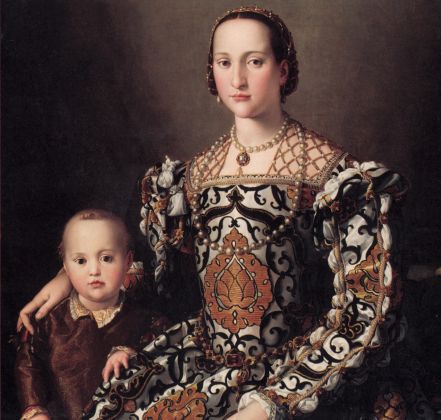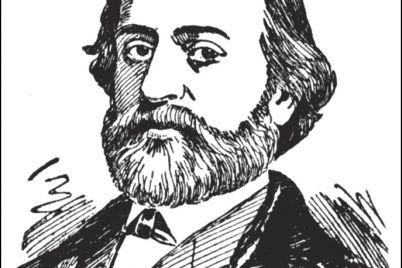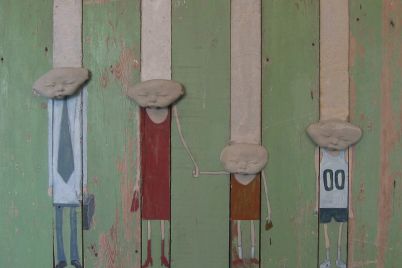The Entertainment section of The Windsor Star announced the opening of Magnificenza! The Medici, Michelangelo, and the Art of Late Renaissance Florence with an enticing photo collage of the treasures ready for viewing at the Detroit Institute of Arts (DIA). Not the threat of war nor long lines at the Ambassador Bridge and the Detroit-Windsor Tunnel could keep me away. The exhibition, which opened March 16, runs through to June 8 at the Institute (5200 Woodward Avenue in the Motor City).
My first thoughts navigated to the irony of such a show in this city, which, I dare say, does not elicit thoughts of a cultural Mecca these days. In fact, a secondary headline on the same page of the paper had a shot of Rap star Eminem and a piece on the recent release of the DVD version of his movie, 8-Mile, which graphically exposes the culture which usually comes to mind when one thinks of Detroit. Even the tiny photo of the Rap phenomenon in the far left corner of the page jars the viewer. How can Magnificenza and Eminem share the same space? And yet, in Detroit, they do.
This counterpoint brings me back to something I have heard numerous times: that the US, and thus Detroit, have the best and the worst of everything. And so, as I crossed the bridge I prepared myself for the onslaught of burned out houses, derelicts, clunker cars emitting the beat of Rap music, and other stereotypical, but existing realities. I was headed for the cultural sanctuary of the DIA, a stone’s throw from downtown – a world away from these other realities.
The DIA is itself magnificent, as are so many buildings in Detroit. Once known as the Paris of the Mid-West, Detroit has prized jewels imbedded into its fabric waiting to be refurbished: fabulous homes, mansions, estates, synagogues, churches, cathedrals, movie houses, theatres and restaurants. The DIA and its treasures are remnants of that glorious past I recall so well, and the fact that this splendid exhibition is here is evidence of the constant, and sometimes uphill battle, to bring back those days of glory.
Anyone who can make it to the Institute to see Magnificenza! will be struck with awe. Apart from the building and the permanent exhibitions, viewing the treasures of Michelangelo and his contemporaries, in this environment, sweeps you into a wondrous world.
The exhibition requires nineteen rooms which hold 180 works from the period. Brochures tell us that seventy-seven lenders in eight countries contributed to the show, including Queen Elizabeth, the Louvre in Paris, the Met in New York, the Ghetty in Los Angeles, the Gallerie Borghese in Rome and the Academia in Venice. The DIA collaborated with several Florentine museums and was able to obtain six drawings and three sculptures by the master himself, Michelangelo. Already housing an impressive collection of Italian art, the DIA has long been involved with Florence and Italy. In fact, the Kresge Court in the Institute is itself a replica of an Italian piazza.
The exhibition begins with the era of Grand Duke Cosimo de Medici and his wife, Eleonora of Toledo, in 1537 and takes us to 1621. Inside the DIA, as we encounter masterpieces and listen to our headphones for background information, we can not help but think of the ironies of that era: conspicuous consumption surrounded by abject poverty. Ruthlessness and treachery went hand in hand with art. Cosimo, we are told, mercilessly suppressed opposition and conquered neighbouring cities in Tuscany while developing a court which produced spectacular works of art. What was the connection? Why would such a man, with Michelangelo’s assistance, found the Academy of Design – Europe’s first art academy? Why collect and commission such marvelous treasures while holding on to power with all the means available?
The statues, bronzes, paintings, and other artifacts seem to answer the question. The bronze figure of a Roman god chopping off the head of the enemy is a startling reminder of the power of the Medici clan. The conspicuous consumption, the glorious costumes, the jewels, the well-fed faces and muscular bodies pictured are testimony to a strong governing elite who wallowed in wondrous richness few of us could ever imagine. Art and power, this exhibition tells us, go hand in hand.
Because I am Italian and I know that my homeland is bursting with artistic treasures, I have always had an ambivalent feeling towards this fact. It has been said that our little peninsula alone houses the largest proportion of the world’s artistic wonders. There is a sense of pride at what humanity is able to create, at the beauteous objects man can envision and produce; but then I think of the cost of such splendour. This is when the sense of guilt kicks in. There are times when the knowledge of the extravagance which led to the creation of the magnificent pieces I can enjoy today leaves me ambivalent. There were several chopped heads in this exhibition! They subdued my enjoyment of murals of wonderful, tranquil gardens, colourful tapestries, and handsome faces depicted in the busts and paintings.
Other more intimate facts gleaned from the recordings, as I viewed the masterpieces, are titillating. Cosimo’s wife, Eleanor of Toledo, was a great advocate of the arts and was involved in the founding of the literary academy. She supported poets like Laura Battiferri. But Eleanor, who had eleven children, also “gambled habitually.” My common sense makes me wonder how much help she must have had with the children and the household chores, permitting her time for other pursuits.
As a writer, I know it is naive to think most artists can chase their dreams without some sort of material support. Then, it was the Grand Dukes; today it may be the government grant or some local initiative. In this sense, we are beholden to the Medici for having encouraged the production of what we can view at the DIA regardless of their intentions. As the article in The Windsor Star states, “The court portraits of this haughty looking clan suggest any invitation to a state banquet might mean you were the dessert. And yet the rich and powerful certainly can be gorgeous to look at.” How true. We forget why these objects were created, and immerse ourselves in their exquisite beauty. That takes me back to Eminem’s 8-Mile and how it contrasts the world of the Medici. 8-Mile is not a pretty world. Watching it with my son, and knowing it is every bit as real as it gets, is it any wonder we prefer to let our gaze fall upon what is inside the DIA?
As I meandered through the nineteen rooms, I was transfixed and transposed. Emerging from the dimly lit rooms onto one of the splendid, sun-lit open courts of the Institute, it was like being embraced by the possibilities before us – if only we are encouraged and given the chance. Even Eminem, I am told, has escaped from the trash of his roots to a more beautiful world through his efforts, regardless of what we might think of those efforts. And, as I emerge from the spectacular edifice of the DIA and onto Woodward Avenue, Detroit’s main drag, to begin my drive home, I am once again stunned by the dichotomy of this city. I catch a glimpse of a golden Madonna atop a church, sparkling in the morning sun, a street person in a wheelchair attempting to cross Woodward, the beautiful fa栤e of the Fox Theatre, gorgeous mansions surrounded by burned out homes, two brand new stadiums that soar above the city; next to these, more homes collapsing into the dust. Cranes and bulldozers everywhere attempting to restore the Paris of the Mid-West. I cross the tunnel into my tranquil city, which does not have such a split personality, and say a silent thank you to the powers that be. I have made the trip safely.
There is a feeling of calm as I reach my shores, but also a sense of letdown. We do not have the best and the worst; we do not have 8-Mile and Magnificenza. I retreat into my quiet life and feel the guilt again. I have enjoyed myself immensely at the DIA, but at what cost? I return to my work, writing, and think of the horror of war, which today hangs over me and the rest of us, casting a shadow on the world I have just witnessed inside the DIA. And yet, I continue to exercise my pen, just as the Renaissance artists continued to express themselves through the arts. And, I must admit, it is Magnificenza!, the exhibition, which has stayed with me, and not 8-Mile. Such is the power of Art.
Marisa De Franceschi is a novelist and critic. She makes her home in Windsor, Ontario.
First published in Accenti Magazine, Issue 2.



